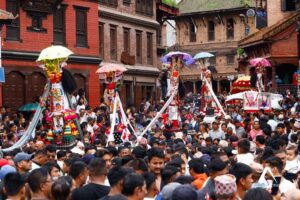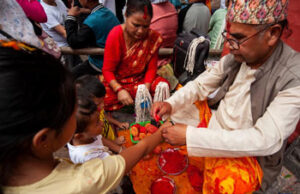Nepal, a country where spirituality meets festivity, comes alive every August with two uniquely contrasting yet equally significant festivals: Janai Purnima and Gai Jatra. Celebrated around the full moon day of Shrawan (August), these festivals highlight the beautiful duality of Nepali culture—sacred rituals on one hand and joyful satire on the other.
Janai Purnima is a solemn Hindu ceremony observed mainly by Brahmins and Chhetris. It involves the changing of the sacred thread, symbolizing renewal and purification. In contrast, Gai Jatra, rooted in Newar tradition, is a humorous and heartfelt tribute to the departed. Families who have lost loved ones join public processions with cows or children dressed as cows, while satirical performances bring laughter to the streets. These festivals, celebrated within days of each other, together embody the Nepali spirit of reverence, resilience, and community.
Janai Purnima traces its origins to ancient Vedic traditions. According to Hindu mythology, Lord Vishnu tied the first sacred thread to protect the gods during a battle. This practice evolved into today’s ritual of changing the Janai, signifying spiritual rebirth and devotion. The festival is also linked with Rishi Tarpani, a ritual honoring ancient sages, and Raksha Bandhan, a thread-tying ceremony symbolizing sibling bonds.
Gai Jatra has its roots in the Malla period of Nepal. Legend says King Pratap Malla instituted the festival to console his grieving queen after their son’s death. He invited families who had lost loved ones to parade in cow processions through Kathmandu. The king realized that laughter could heal, so the festival grew to include satire and comedic expression, helping communities cope with grief through joy. These stories continue to give both festivals deep meaning in modern Nepal.
On Janai Purnima, devout Hindus wake early, bathe in sacred rivers like the Bagmati or Gosainkunda, and visit temples. Male members of Brahmin and Chhetri families undergo the ritual of changing their Janai (sacred thread), performed by family priests. This act symbolizes spiritual purification and commitment to a virtuous life.
Another important ritual is the tying of the Rakshya Bandhan, a sacred yellow thread around the wrist by priests, believed to offer protection. Sisters also tie colorful threads around their brothers’ wrists, wishing them safety and long life. After the rituals, families gather to enjoy Kwati, a nutritious sprout soup believed to boost health during the monsoon season. The atmosphere is reverent, reflective, and rooted in family bonds and spiritual renewal.
Gai Jatra, or the “Cow Festival,” is unlike any other. While it honors the memory of deceased loved ones, it does so through humor, music, and satire. Families who have lost someone during the past year participate by parading a cow or a young boy dressed as a cow through the streets. In Hindu belief, cows help guide departed souls to the afterlife.
In Newar communities, especially in Kathmandu Valley, the streets come alive with costumed performers, traditional dances, and social satire. People openly poke fun at politicians, celebrities, and cultural norms. This blending of grief with comedy creates a unique environment where the community mourns together while finding strength in laughter. Gai Jatra is a testament to the resilience and creative spirit of the Nepali people.
For a truly immersive experience, head to Pashupatinath Temple in Kathmandu during Janai Purnima. Thousands of devotees gather to perform rituals and receive the Rakshya Bandhan. Another incredible destination is Gosainkunda, a sacred alpine lake where thousands of pilgrims trek to bathe on this auspicious day.
To witness the full spectacle of Gai Jatra, Bhaktapur is the place to be. The medieval city hosts colorful parades, satirical plays, and traditional Newar dances. Kathmandu Durbar Square also showcases lively Gai Jatra celebrations with processions and mockery skits. Kirtipur and Patan offer more localized versions of the festival, each with its own flavor. Whether you seek spiritual serenity or cultural celebration, these destinations bring Nepal’s festivals to life.
If you plan to experience Janai Purnima and Gai Jatra, preparation is key. For Janai Purnima, wear modest clothing, respect the temple rituals, and avoid taking photos during sacred moments. Be sure to try Kwati at local eateries, and consider visiting Gosainkunda if you’re up for an adventurous trek.
For Gai Jatra, expect large crowds and vibrant chaos. Keep your belongings safe, be open to the satire (some jokes can be bold), and enjoy the performances respectfully. Participate by watching the parades or supporting local artists and vendors. Learn a few Nepali phrases—a simple “Namaste” goes a long way. Plan your accommodation in advance, as many locals and tourists travel for these festivals. Most importantly, come with an open heart and curious mind.
August in Nepal is a sensory feast. During Janai Purnima, the air is filled with the fragrance of incense, temple bells, and the savory aroma of Kwati, a hearty soup made of nine types of sprouted beans. This dish, traditionally prepared in every home, is believed to strengthen the immune system during the rainy season.
Gai Jatra brings a riot of color and sound to the streets. Children wear elaborate costumes, participants paint their faces, and parades feature colorful umbrellas, cows, and comical banners. The fusion of traditional instruments, laughter, and community storytelling creates a joyous atmosphere. Local snacks and sweets, street performances, and impromptu skits make this time especially vibrant for visitors. The entire month celebrates life, remembrance, and renewal.
Janai Purnima and Gai Jatra, though different in tone, reflect the multifaceted identity of Nepal. One festival emphasizes spiritual discipline and sacred tradition, while the other uses creativity and satire to cope with life’s challenges. Together, they show how deeply faith and humor are woven into the cultural fabric of Nepal.
In a society where religion, community, and art are deeply interconnected, these festivals offer a mirror to Nepali life. They reveal how people here honor their past, stay spiritually grounded, and yet embrace laughter even in times of sorrow. For travelers, these festivals provide a rich, immersive way to understand the soul of Nepal.
Leading up to Janai Purnima, the month of Shrawan is full of devotion, especially to Lord Shiva. Mondays during Shrawan are considered sacred, and women observe fasting and visit temples in colorful attire. Following Janai Purnima is Krishna Janmashtami, celebrating the birth of Lord Krishna with night vigils and temple festivities.
Shortly after Gai Jatra, the Kathmandu Valley gears up for Indra Jatra, another iconic festival that honors the god of rain. It includes masked dances, chariot processions, and the display of the living goddess Kumari. Further ahead, Teej and Dashain follow, marking the upcoming festive season. This sequence of festivals keeps Nepal culturally vibrant and spiritually alive from summer into autumn.
They are celebrated in August during the full moon (Janai Purnima) and the following day or so (Gai Jatra).
Yes. While sacred thread rituals are private, tourists can observe and receive Rakshya Bandhan. Gai Jatra is very inclusive and open.
Cows are believed to guide the souls of the deceased toward liberation in the afterlife.
Modest clothing is recommended. For Janai Purnima, temple attire is appropriate. For Gai Jatra, feel free to enjoy the colors but be respectful.
Visit NepalTourPackage.com to explore specially curated festival tours, local guides, and travel experiences tailored to your interests.
